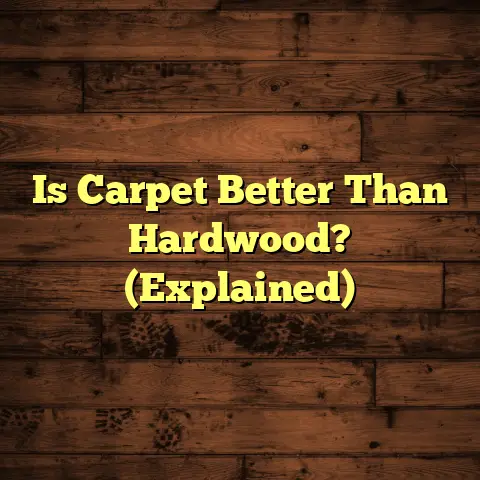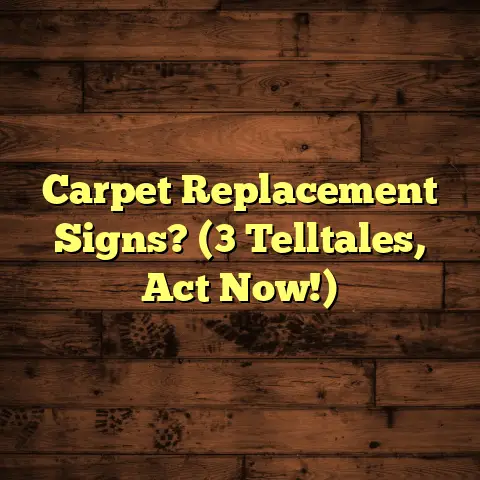Fix Squeaky Floors Under Carpet? (6 Quick Tricks!)
It’s like living in a haunted house, except the ghosts are just poorly installed floorboards.
The good news is, you don’t have to live with it! I’m going to share 6 quick tricks to fix those squeaky floors under your carpet.
Imagine this: you’re settling in for a cozy evening, maybe watching a movie, and creak…squeak…creak.
Or, you’re trying to sneak to the kitchen for a midnight snack, and the floor announces your presence.
Sound familiar? Don’t worry; I’ve got your back. Let’s dive in and silence those squeaks!
Understanding the Cause of Squeaky Floors
Before we grab our tools, let’s understand why floors squeak in the first place. It’s not always as simple as “old house.”
The Anatomy of Floorboards
Think of your floor like a sandwich. You’ve got the subfloor (the bread), the floorboards (the filling), and then the carpet on top (the… lettuce?).
The subfloor is usually plywood or OSB, and the floorboards are what you walk on.
They’re attached with nails or screws. The problem? Over time, these fasteners can loosen, and the wood rubs together, causing that dreaded squeak.
Different flooring materials also play a role. Hardwoods tend to squeak more than softer woods, simply because they’re denser and create more friction.
Common Causes of Squeaks
So, what makes those floorboards start rubbing?
-
Settling: Houses settle over time. It’s a natural process, but it can shift the floor joists and subfloor, leading to movement and squeaks.
-
Humidity Changes: Wood expands and contracts with changes in humidity. This can loosen fasteners and create gaps between boards. I’ve seen it happen a lot!
-
Wear and Tear: Let’s face it, we walk on our floors a lot. All that foot traffic can wear down the wood and loosen the connections over time.
I remember one house where the squeak was so bad, it sounded like a flock of birds was living under the carpet.
Turns out, the joists had settled, and every step caused the floorboards to grind against each other.
Time for our first trick!
Quick Trick #1 – Lubricate the Floorboards
This is often the easiest and quickest fix. Think of it like WD-40 for your floor.
Materials Needed
- Talcum powder (baby powder works great!)
- WD-40 (or a similar penetrating oil)
- Silicone spray (optional, but good for long-term lubrication)
- A small nozzle to apply the lubricant
- A flashlight
Step-by-Step Guide
-
Locate the Squeak: Walk around the room and pinpoint exactly where the squeak is coming from. Mark the spot with tape. This is crucial!
-
Apply Talcum Powder: Sprinkle talcum powder around the squeaky area, working it into the cracks between the floorboards. The powder acts as a dry lubricant, reducing friction.
-
Spray with Lubricant: If the powder doesn’t do the trick, try WD-40 or silicone spray. Use the nozzle to apply a small amount of lubricant into the cracks. Be careful not to overdo it!
-
Test and Repeat: Walk on the area again to see if the squeak is gone. If not, repeat steps 2 and 3. You might need to apply a few times to get the lubricant deep enough.
Pro Tip: Use a flashlight to help you see the cracks between the floorboards. This makes it easier to target the lubricant.
Benefits of Lubrication
Lubrication can provide an immediate reduction in noise. The powder and oils reduce friction, allowing the boards to move silently. It’s a temporary fix, but it can buy you some time while you consider more permanent solutions.
Quick Trick #2 – Use Shims to Stabilize
Sometimes, the problem isn’t just friction; it’s that the floorboards are loose and bouncing. That’s where shims come in.
Understanding Shims
Shims are thin, tapered pieces of wood that you can insert between the floor joists and the floorboards to stabilize them. They act like tiny wedges, filling gaps and preventing movement.
Installation Process
-
Access the Subfloor: You’ll need to access the subfloor from below, usually in a basement or crawl space.
-
Locate the Squeak from Below: Have someone walk on the squeaky spot while you’re in the basement. This will help you pinpoint the exact location of the loose boards.
-
Insert Shims: Gently tap shims into the gap between the floor joist and the subfloor, right under the squeaky area. Use a hammer and a wood block to avoid damaging the shims.
-
Test and Secure: Have someone walk on the floor again to make sure the squeak is gone. Once you’re satisfied, you can secure the shims with construction adhesive or small nails.
Pro Tip: Don’t force the shims in too tightly! You want to stabilize the boards, not lift them.
Advantages of Using Shims
Shims provide a long-term solution by physically stabilizing the floorboards. They prevent movement and reduce the likelihood of the squeak returning. Plus, it’s a relatively inexpensive fix.
Quick Trick #3 – Nail or Screw Down Loose Boards
This is a classic fix for a reason: it works! If the boards are loose because the nails or screws have come loose, simply re-fastening them can solve the problem.
Identifying Loose Boards
The key here is to feel for the movement. Walk around the squeaky area and pay attention to which boards feel like they’re moving independently.
Nailing/Screwing Process
-
Locate the Joists: Use a stud finder to locate the floor joists underneath the carpet. You’ll want to nail or screw into the joists for maximum stability.
-
Pre-Drill Holes: Drill pilot holes through the carpet and the floorboards, into the joists. This will prevent the wood from splitting and make it easier to drive the nails or screws.
-
Nail or Screw: Drive nails or screws into the pilot holes, securing the floorboards to the joists. Use screws for a more secure and longer-lasting hold.
Pro Tip: Use countersinking screws so the screw heads sit flush with the floorboards. This will prevent them from snagging on the carpet.
Safety Tips
- Wear safety glasses to protect your eyes from flying debris.
- Use a stud finder to avoid hitting electrical wires or plumbing.
- Be careful not to over-tighten the screws, which can damage the wood.
Quick Trick #4 – Carpet Padding Adjustment
Believe it or not, sometimes the squeak isn’t the floorboards themselves, but the carpet padding underneath.
Examining Carpet Padding
If the padding is old, worn, or improperly installed, it can bunch up and create friction against the subfloor. This friction can cause squeaks that sound like they’re coming from the floorboards.
Adjusting Carpet Padding
-
Lift the Carpet: Carefully lift the carpet around the squeaky area. You might need a carpet stretcher to get it taut again.
-
Inspect the Padding: Look for areas where the padding is bunched up, torn, or worn thin.
-
Reposition or Replace: If the padding is just bunched up, smooth it out and reposition it. If it’s damaged, replace it with a new piece of padding.
-
Reattach the Carpet: Use a carpet stretcher to reattach the carpet, making sure it’s tight and smooth.
Pro Tip: Use double-sided carpet tape to secure the padding to the subfloor. This will prevent it from bunching up again.
Impact on Squeaks
Adjusting the carpet padding can significantly reduce noise levels, especially if the padding was the primary cause of the squeak.
Quick Trick #5 – Use Construction Adhesive
For a more robust fix, construction adhesive can be your best friend. It’s like glue for your floors!
Understanding Construction Adhesive
Construction adhesive is a strong, flexible adhesive that’s designed to bond wood to wood. It can fill gaps, reduce movement, and prevent squeaks.
Application Steps
-
Access the Seams: You’ll need to access the seams between the floorboards. This might involve lifting the carpet slightly.
-
Apply Adhesive: Use a caulking gun to apply a bead of construction adhesive along the seams.
-
Press Down: Press down firmly on the floorboards to ensure the adhesive bonds properly.
-
Weight Down: Place heavy objects (like books or bricks) on the area to weight it down while the adhesive dries.
Pro Tip: Use a damp cloth to wipe away any excess adhesive before it dries.
Benefits of Adhesive
Construction adhesive can provide a long-lasting fix by permanently bonding the floorboards together. It’s especially effective for fixing squeaks caused by loose seams.
Quick Trick #6 – Call in the Professionals
Sometimes, DIY fixes just aren’t enough. If you’ve tried these tricks and the squeaks persist, it might be time to call in the pros.
When to Seek Help
- Extensive Damage: If the squeaks are widespread and affect multiple rooms, it could indicate a more serious problem with the subfloor or joists.
- Structural Issues: If you suspect structural issues, like rotting wood or damaged joists, it’s best to consult a professional.
- Lack of Confidence: If you’re not comfortable working with tools or accessing the subfloor, it’s better to leave it to the experts.
Finding the Right Expert
- Ask for Referrals: Ask friends, family, or neighbors for recommendations.
- Check Online Reviews: Read online reviews to get an idea of the contractor’s reputation and quality of work.
- Get Multiple Quotes: Get quotes from multiple contractors to compare prices and services.
Cost Considerations
Professional flooring repairs can range from a few hundred dollars to several thousand, depending on the extent of the damage. Be sure to get a detailed estimate before hiring a contractor.
Conclusion
Squeaky floors can be a real nuisance, but they don’t have to ruin your peace and quiet. By understanding the causes of squeaks and using these six quick tricks, you can silence those noisy floorboards and reclaim your comfort.
Don’t let those squeaks drive you crazy any longer! Take action, implement these solutions, and enjoy your peaceful, squeak-free home. You deserve it!





